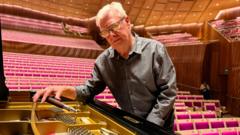Who Has Been Sydney Opera House's Go-To Guy for 50 Years?

The End of an Era: Terry Harper’s Legacy at the Sydney Opera House
As the sun sets over the Sydney Opera House, casting long shadows on the iconic sails, a chapter closes in the venue's storied history. For nearly five decades, Terry Harper has been the unseen maestro behind the scenes, tuning the pianos that have serenaded some of the world's most celebrated musicians. His retirement not only marks the end of a personal journey but also signifies the conclusion of a family legacy that began with his father when the Opera House first opened its doors in 1973. In this article, we’ll explore the life and legacy of Terry Harper, the intricate art of piano tuning, and the unique relationship he has cultivated with the Sydney Opera House over the years.
A Family Legacy Begins
The Sydney Opera House, a UNESCO World Heritage site, officially opened its doors on October 20, 1973, when Queen Elizabeth II declared it fit for performance. The venue has since become a cultural icon, attracting millions of visitors each year, and hosting a myriad of events ranging from concerts to theatrical productions. However, behind the scenes, a different story unfolds through the hands of a dedicated piano tuner.
Terry Harper's journey began in the shadow of the Opera House, where he was introduced to the world of music by his father, Ron Harper. Ron, a skilled piano tuner and performer from Liverpool, emigrated to Sydney and quickly made his mark on the local music scene. Young Terry would accompany his father to nightclubs, absorbing the vibrant atmosphere filled with world-class acts such as Dame Shirley Bassey and Liza Minnelli.
Early Inspirations
Growing up in such a rich musical environment instilled in Terry a deep appreciation for the art form, even if he chose not to pursue it himself. “It was an interesting childhood,” he reflects, chuckling at the memories of attending performances in his school uniform. While he dabbled with the piano and drums, it became clear that his true calling lay in the precision of piano tuning.
The Art of Piano Tuning
Piano tuning is a specialized skill that requires not only knowledge but also a finely tuned ear. The process involves adjusting the tension of the piano strings to ensure they vibrate in harmony. A standard piano typically contains 220 to 250 strings, depending on its design, and each string must be meticulously tuned to achieve the desired sound.
Tuning Techniques
Terry explains that the tuning process can take up to 90 minutes, depending on the piano's condition. Each of the 30 pianos housed within the Sydney Opera House requires tuning before every performance. “Once they start to deviate from the same frequency, they cause these things which we call beats,” he elaborates, describing the intricate sounds that indicate a piano is out of tune.
Unlike string instruments such as guitars, which can be tuned with relative ease, pianos present a unique challenge. “It’s difficult to master,” Terry admits. His ability to discern minute differences in pitch has been honed over decades of experience, allowing him to walk into a room and instantly recognize when a piano is out of tune.
The Demands of the Job
The role of a piano tuner is often demanding, requiring flexibility and dedication. Terry notes that his work schedule often includes early mornings and late nights, with some days demanding two or three tuning sessions. “It doesn’t stop,” he says. The pressure of ensuring each piano is performance-ready can be relentless, but the rewards are equally rewarding.
Memorable Moments and Celebrity Encounters
Throughout his tenure at the Opera House, Terry has had the rare opportunity to interact with some of the world’s most celebrated musicians and performers. The backstage environment is one filled with excitement and creativity, where Terry has witnessed countless memorable moments. From tuning pianos for orchestras to preparing instruments for solo performances, each day has brought new experiences.
Among his many memorable encounters, Terry recalls tuning for international stars, sharing anecdotes about the personalities behind the music. “I’ve been fortunate to brush shoulders with some of the globe’s most decorated musicians,” he states, a hint of pride evident in his voice. Such experiences not only enriched his career but also deepened his love for the craft.
Connecting with the Community
Beyond the glitz and glamour of the performances, Terry has built lasting relationships with the people who work at the Opera House. “Piano tuners, we’re fairly solitary,” he explains. Yet, despite the solitary nature of his work, he has always enjoyed the camaraderie of the staff. This sense of community has made the Opera House feel like a second home, a place where he has spent a significant part of his life.
The Impact of COVID-19
The COVID-19 pandemic brought unprecedented challenges to the performing arts community, and the Opera House was no exception. With performances canceled and venues closed, Terry found himself in a unique situation. “I got quite cozy during COVID, not having to work,” he quips, reflecting on the unexpected break. However, as restrictions eased and performances resumed, the demand for his expertise returned.
Retirement and Reflection
After decades of dedication to his craft, Terry Harper has decided to retire. The decision was not made lightly, and it comes with a mix of emotions. “As my departure has crept closer, a wave of emotions came with it,” he admits. His son, who has pursued a different path in technology, will not be taking up the family legacy, marking the end of an era for the Harpers at the Opera House.
The venue has announced a search for a new contractor to take over the piano tuning responsibilities. “I think somebody owes me some money… I’ve been doing the work of six people,” Terry jokes, illustrating his dedication to maintaining the quality of performances at the Opera House.
Looking Back
As he steps away, Terry reflects on the years spent within the iconic building. “For me, it’s a very happy place. It’s pretty much been my life,” he says, his voice tinged with nostalgia. The legacy he leaves behind is not merely about the pianos he tuned but also the relationships he fostered and the music that filled the halls.
Conclusion
Terry Harper’s retirement signifies the closing of a remarkable chapter in the history of the Sydney Opera House. His unwavering commitment to his craft and the community has left an indelible mark on the venue. As the Opera House prepares to welcome a new piano tuner, the echoes of Terry’s work will continue to resonate within its walls, reminding us of the rich tapestry of music and artistry that defines this iconic structure. The legacy of the Harper family will live on in the melodies that fill the air, a tribute to a life spent in the pursuit of musical perfection.
FAQs
What is the role of a piano tuner?
A piano tuner is responsible for adjusting the tension of a piano's strings to ensure it is in tune and sounds harmonious. This process involves careful listening and expertise in pitch recognition.
How often should a piano be tuned?
A piano should ideally be tuned every six months, but it may require more frequent tuning depending on how often it is used and environmental factors such as humidity.
What makes the Sydney Opera House special?
The Sydney Opera House is renowned for its unique architecture, cultural significance, and role as a leading venue for performing arts. It hosts a variety of events, including concerts, operas, and theater performances.
As we bid farewell to Terry Harper and his legacy at the Sydney Opera House, we are reminded of the importance of craftsmanship and dedication in every art form. What will the future hold for the tunes of the Opera House? #SydneyOperaHouse #PianoTuning #TerryHarper
Published: 2025-06-21 23:37:11 | Category: technology



